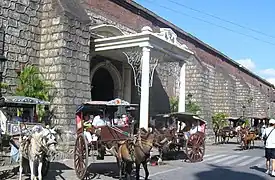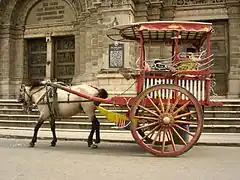| Kalesa | |
|---|---|
_(1923).jpg.webp)  | |
| Application | Transportation |
| Powered | No |
| Self-propelled | No |
| Wheels | 2 |
A kalesa or calesa is a two-wheeled horse-drawn carriage used in the Philippines.[1][2] It is commonly vividly painted and decorated.[3] It was a primary mode of public and private transportation during the Spanish colonial era of the Philippines, though in modern times, they largely only survive as tourist attractions such as in Vigan, Ilocos Sur.
History


Kalesa (from the Spanish word calesa) were first introduced to the Philippines in the 1700s by the Spanish. It became the major public and private form of transport in the Philippines up until the early 20th century.[1] It was also used to transport goods. They were manufactured by traditional workshops known as karoserya.[4]
Use of the kalesa declined in the mid-20th century, when mass public transportation was largely taken over by motorized jeepneys and tricycles. Pressure to phase out kalesas began in the 1940s when the 7000 or so kalesas still operating in Manila started holding up motorized traffic.[5] Kalesa in modern times are largely only used as tourist attractions. They are still preserved in some areas of the Philippines, such as in San Fernando, Pampanga, Vigan and Laoag.[6] Kalesas can also be found in Intramuros, where they cater to tourists and Binondo in Manila, as well as in Iligan, where decorated kalesas can be taken for a ride along a specific street. In Cagayan, kalesas are common, especially in Tuao, Tuguegarao, and other municipalities of the province.
The colorful decorations of the kalesa was also inherited by the post-World War II jeepney (which were known as "auto calesa" from the 1910s to the 1940s). The legacy of the kalesa is also evident in the horse hood ornament of most jeepneys.[3]
Description

The kalesa looks like a two-wheeled inclined cart, and is drawn by a single horse. It is made from wood, metal, or a combination of both. Traditionally it had a single forward-facing bench that can accommodate two passengers. The kalesa driver commonly called as kutsero (Spanish cochero) sits on the driver's seat in front.[7] Both the driver and the passengers are enclosed by a canopy originating from the back of the cab.
American colonial-era kalesas with two side-facing benches (each able to fit two passengers) are known as tartanilla. In modern versions, they can seat eight to ten people. They remain an iconic form of transport in Cebu City.[8]
Large four-wheeled versions of the kalesa were known as karwahe (Spanish carruaje); while drays drawn by carabao (usually used to transport cargo) were known as garetas or kareton (Spanish carretón).[4]
Kalesa had specific terminology for drivers. When a kutsero wants the horse to turn right, he says "mano" while he says "silla" to make the horse turn left.[9]
In popular culture
Composer Ambrosio Del Rosario composed the original music and National Artist of the Philippines Levi Celério wrote the lyrics for a song entitled Kalesa, in honour of the vehicle.[10]
An annual Kalesa Parade is held during the Binatbatan Festival of the Arts of Vigan City.[11]
Gallery
 Kalesa in Manila
Kalesa in Manila Kalesa in Calle Crisologo, Vigan, Ilocos Sur
Kalesa in Calle Crisologo, Vigan, Ilocos Sur Kalesa parked in front of Vigan Cathedral
Kalesa parked in front of Vigan Cathedral.jpg.webp) A kalesa at Binondo, Manila
A kalesa at Binondo, Manila A kalesa in front of the Manila Cathedral
A kalesa in front of the Manila Cathedral
See also
References
- 1 2 Montefalcon, Moreen Ann M.; Cruz, Robin Lawrence I.; Inocencio, Marian Nicole J.; Portus, Alyssa Jean (2019). "An Ergonomic Assessment of the Philippine Kalesa". In Goonetilleke, Ravindra S.; Karwowski, Waldemar (eds.). Advances in Physical Ergonomics & Human Factors. Advances in Intelligent Systems and Computing. Vol. 789. pp. 170–178. doi:10.1007/978-3-319-94484-5_18. ISBN 978-3-319-94483-8. S2CID 169516531.
- ↑ Smith, D.J.M. (1988). A Dictionary of Horse Drawn Vehicles. J. A. Allen & Co. Ltd. p. 33. ISBN 0851314686. OL 11597864M.
Calesa. Two-wheeled passenger cart or heavy gig, used in the Phillipines from the mid-19th century to the 1940's. The driver frequently sat in the rear part of the vehicle, as with an English farm or dairy float. Hung on sideways semi-elliptical springs. Drawn by a single horse.
- 1 2 Chiu, Imes (2008). The Evolution from Horse to Automobile: A Comparative International Study. Cambria Press. pp. 224–229. ISBN 9781604975468.
- 1 2 "The Last Calesa Maker: How A Proud Fernandino Kept A Fading Industry Alive". Capital Town Pampanga. March 28, 2019. Retrieved March 26, 2020.
- ↑ Horn, Florence (1941). Orphans of the Pacific—the Philippines. New York, Reynal & Hitchcock. pp. 23–27.
- ↑ Kalesa. Archived November 11, 2007, at the Wayback Machine Vigan City Philippines – Unesco World Heritage City.
- ↑ Seaver, David (June 1, 1976). "The Calesa of the Philippine Islands". The Carriage Journal. Carriage Association of America. 14 (1): 32–35. Retrieved July 31, 2022.
- ↑ "Tartanilla Cebu's fading chariots". CDN. August 17, 2018. Retrieved December 6, 2020.
- ↑ "Riding The Philippine 'Calesa' and Business". Archived from the original on November 28, 2010. Retrieved November 28, 2010.
- ↑ Kalesa – Video Watch, watch Youtube video, download Youtube video.
- ↑ Rivero, Imelda C. "Vigan's enduring 'kalesas' help keep the city's air clean". Philippine Information Agency. Retrieved March 26, 2020.
External links
 Media related to Calesas at Wikimedia Commons
Media related to Calesas at Wikimedia Commons